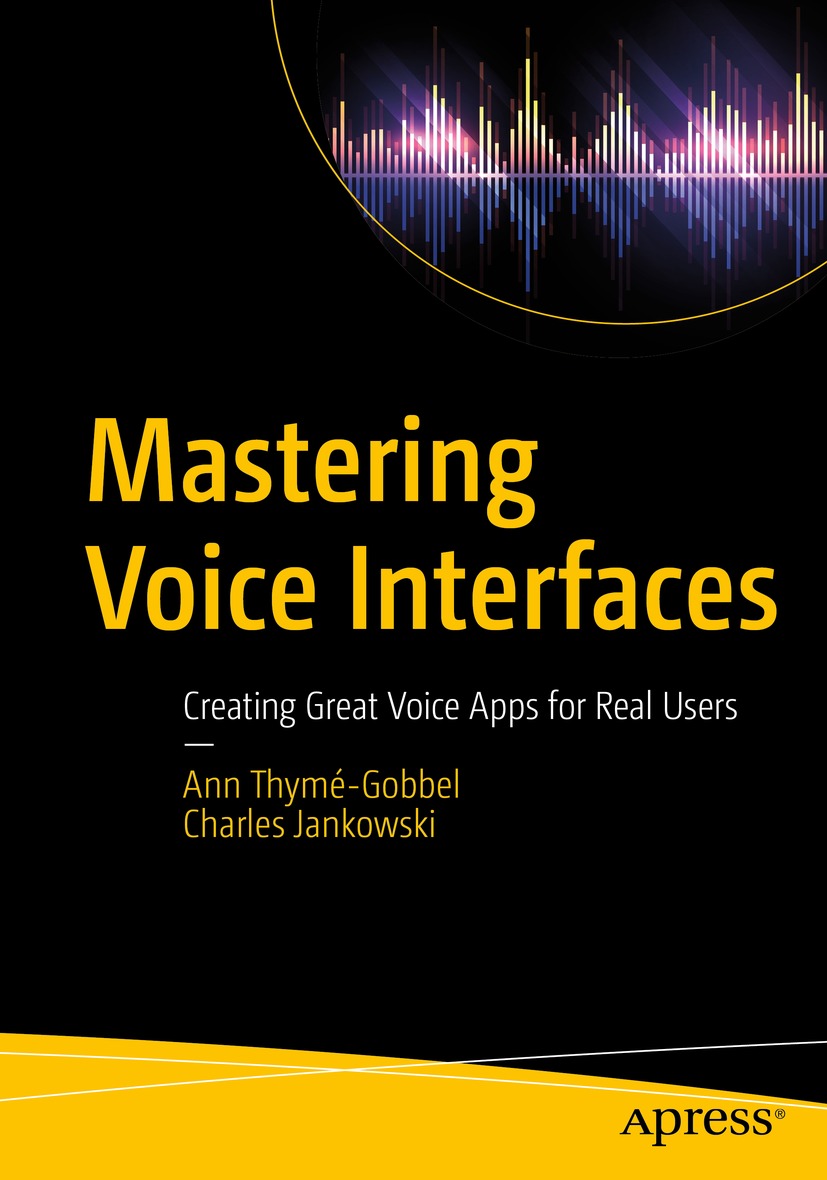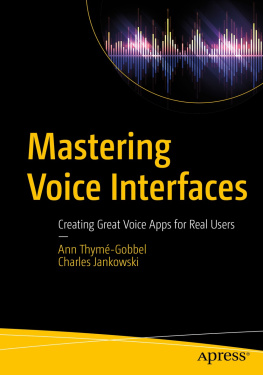Ann Thymé-Gobbel - Mastering Voice Interface
Here you can read online Ann Thymé-Gobbel - Mastering Voice Interface full text of the book (entire story) in english for free. Download pdf and epub, get meaning, cover and reviews about this ebook. year: 2021, publisher: Apress, genre: Home and family. Description of the work, (preface) as well as reviews are available. Best literature library LitArk.com created for fans of good reading and offers a wide selection of genres:
Romance novel
Science fiction
Adventure
Detective
Science
History
Home and family
Prose
Art
Politics
Computer
Non-fiction
Religion
Business
Children
Humor
Choose a favorite category and find really read worthwhile books. Enjoy immersion in the world of imagination, feel the emotions of the characters or learn something new for yourself, make an fascinating discovery.
- Book:Mastering Voice Interface
- Author:
- Publisher:Apress
- Genre:
- Year:2021
- Rating:3 / 5
- Favourites:Add to favourites
- Your mark:
- 60
- 1
- 2
- 3
- 4
- 5
Mastering Voice Interface: summary, description and annotation
We offer to read an annotation, description, summary or preface (depends on what the author of the book "Mastering Voice Interface" wrote himself). If you haven't found the necessary information about the book — write in the comments, we will try to find it.
Mastering Voice Interface — read online for free the complete book (whole text) full work
Below is the text of the book, divided by pages. System saving the place of the last page read, allows you to conveniently read the book "Mastering Voice Interface" online for free, without having to search again every time where you left off. Put a bookmark, and you can go to the page where you finished reading at any time.
Font size:
Interval:
Bookmark:


Any source code or other supplementary material referenced by the author in this book is available to readers on GitHub via the books product page, located at www.apress.com/978-1-4842-7004-2. For more detailed information, please visit http://www.apress.com/source-code.
This Apress imprint is published by the registered company APress Media, LLC part of Springer Nature.
The registered company address is: 1 New York Plaza, New York, NY 10004, U.S.A.
To all who strive to create better voice experiencesand all who want to use them.
We live in a golden age of voice technology. Conversational voice-first interactionshuman-computer interfaces that use automatic speech recognition (ASR) and natural language understanding (NLU)suddenly seem to be everywhere, from dictation and questions answered by Siri ; home interactions and assistants like Amazon Alexa, Google Assistant, Microsoft Cortana, and Samsung Bixby; and mobile voice requests and enterprise solutions with Nuance and others to in-car control, games, and more. Anywhere you turn, you see people talking to devices or talking about talking to them!
This explosion of voice comes out of a perfect storm of significant technology improvements and ease of access for anyone wanting to create something they and others can talk to. Its a glorious gold rush at its infant stages of untapped potential. Its exciting both for those new to talking to devices and to those of us who have been working in voice and natural language automation for many years. Voice interaction creation used to be the realm of a small handful of designers and developers (like us) in dark corners. Now its out in the light, and everyone wants to do it. Many tools can help you build a functional voice interaction quickly. It seems like voice can do anything!
But with lofty promises comes the risk of letdown due to unfulfilled expectations, disappointed developers, and disenchanted users. Its already happening. Many voice solutions have low ratings, and its not hard to see why. We both have several devices that we talk to: smart speakers on different platforms, lights, audio receivers, TVs, and, yes, even a fake fireplace. And we use these devices, but all too often, we run into unexpected and even undesired experiences, like this recent interaction one of us authors had when wanting to turn off a light. In Figure , were letting our stick robot stand in for the actual intelligent voice assistant (IVA) .

An actual conversation between a user and a voice assistant controlling household lights
We watch our friends ask voice devices for information and entertainment, try various approaches, and too often not get the result they hoped for. They settle on a few use cases that work while they also get frustrated. Yet other friends with voice development experience worry about a Voice Winter, where an emerging technology cant keep up with the hype once its in users hands. Large companies are betting big on voice, but only a few voice apps are delivering the ROI many hope for. Why? Theres no lack of opportunity, but the streets arent lined with gold either. Gartners 2019 hype cycle analysis concludes that voice assistants are at risk of falling into the dreaded valley of despair because of fundamental barriers and challenges.
Having been around voice for quite a while, weve seen what voice solutions can do, so we started wondering, Why isnt it better? And we started analyzing, I see what happened there It wasnt tuned enough or There was an incorrect assumption about context or That wording is too vague or It's not taking meaning into account and so on, which lead to We want to use voice devices that work well!
We looked at the available resources and found that even when the material is good, the typical focus is only on one portion of the full voice creation process, either design or development. Missing was something that brought it all together to explain the why and how of voice as an interface modality without the limitations of a specific platform. Something explaining why the needs of the users, system, and business all must be met and work together. Something incorporating voice-appropriate discovery and testing methods for complex real-world applications . Creating voice applications without understanding how people process and generate speech is a bit like judging the readiness of pasta by throwing it at the wall to see if it sticks. You can do it, but its unnecessarily messy and probably doesnt have the result you hoped for.
This is where our motivation for this book began to take shape. How can we share our experiences? Canwehelp others succeed and avoid unnecessary mistakes? What do we wish someone could teach us today based on what we now know about voice development? Over the years, weve learned that success in this space starts with understanding whats special about spoken natural language . Weve worked at big companies and small startups, in different organizations doing product development, client services engagements, R&D, design, development, testing, research, teaching, and even marketing research, strategy, and planning. All of it has convinced us that the way to create successfulvoice interactionsis to work with a team that understands real users needs to apply the available technology and resources appropriately.
Heres the good news: fully functional voice systems have been around for quite a while and analysis of spoken language much longer. Voice systems did not suddenly appear out of nowhere a few years ago, nor will they disappear anytime soon. If we thought voice had nothing to offer, we wouldnt stay in this field our whole careers! But we do think about how to avoid a Voice Frost. The core of Alexa and Google Assistant voice design is based on best practices built on years of well-tested observations. And theres a reason for that:
Font size:
Interval:
Bookmark:
Similar books «Mastering Voice Interface»
Look at similar books to Mastering Voice Interface. We have selected literature similar in name and meaning in the hope of providing readers with more options to find new, interesting, not yet read works.
Discussion, reviews of the book Mastering Voice Interface and just readers' own opinions. Leave your comments, write what you think about the work, its meaning or the main characters. Specify what exactly you liked and what you didn't like, and why you think so.







